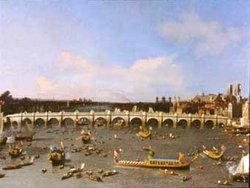Lord Mayor's Show
|
|
The Lord Mayor's Show is one of the longest established and best known annual events in London. The Lord Mayor in question is that of the City of London the historic centre of London which is now the metropolis's financial district, informally known as the Square Mile. A new Lord Mayor is appointed every year and the public parade that is made of his inauguration reflects the fact that this was once one of the most prominent offices in England. The Lord Mayor still has an administrative role in the Square Mile, but London's primary mayor is a different individual entirely, namely the elected head of the Greater London Authority. The event is a street parade which in its modern form is a fairly light hearted combination of traditional British pageantry and elements of carnival.
On the day after being sworn in, the Lord Mayor and several others participate in a procession from the City of London to the Royal Courts of Justice in the City of Westminster, where the Lord Mayor swears his allegiance to the Crown. Originally, the Show occurred annually on 28 October. In 1751, Great Britain replaced the Julian Calendar with the Gregorian Calendar; the Lord Mayor's Show was then moved to 9 November. In 1959, another change was made; now, the Lord Mayor's Show is held on the second Saturday in November. The Lord Mayor's Show has regularly been held on the scheduled day; it has not been moved since 1852, when the Show made way for Arthur Wellesley, 1st Duke of Wellington's funeral. The Show was not interrupted by the Second World War.
Formerly, the route was varied each year so that the procession could pass through the Lord Mayor's home ward; since 1952, however, the route has been fixed. The Lord Mayor rode on horseback or went on a barge via the River Thames, based on the route chosen. After Sir Gilbert Heathcote was unseated by a drunken flower girl in 1710, state coaches replaced horses. Barges have not been used since 1856. Now, the Lord Mayor travels in a State Coach that was built in 1757 at a cost of £1,065.0s.3d. (over £120,000 in modern terms).
The Twelve Great Livery Companies—the Mercers, Grocers, Drapers, Fishmongers, Goldsmiths, Merchant Taylors, Skinners, Haberdashers, Salters, Ironmongers, Vintners and Clothworkers—participate as of right; other Livery Companies participate by invitation. Other participants include bands and members of the military.
The procession begins at Guildhall; the Lord Mayor joins the rear from his official residence, Mansion House. Along the route, the Lord Mayor stops at St Paul's Cathedral in order to receive a blessing from the Dean. When he arrives at the Royal Courts of Justice in Westminster, he takes the oath of allegiance; the return procession then begins from Temple Place. When returning, as when going to the Royal Courts of Justice, the Lord Mayor joins the back of the procession. When he returns to Mansion House, members of the Corporation of London welcome him. The parade, which begins at about eleven o'clock in the forenoon, concludes at about half past two in the afternoon. The procession is over three miles (roughly five kilometres) long, but the route itself is much shorter; the head of the procession reaches the end of the route before the Lord Mayor even leaves his home. In the evening, a fireworks display is held.

